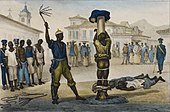
Back عقوبة بدنية Arabic تعذيب الخدامين ARZ Bədən cəzası Azerbaijani Càstig físic Catalan Tělesný trest Czech Cosb gorfforol Welsh Korporlig afstraffelse Danish Körperstrafe German Τιμωρητικός ξυλοδαρμός Greek Korpa puno Esperanto
| Part of a series on |
| Corporal punishment |
|---|
 |
| By place |
| By implementation |
| By country |
| Court cases |
| Politics |
| Campaigns against corporal punishment |
A corporal punishment or a physical punishment is a punishment which is intended to cause physical pain to a person. When it is inflicted on minors, especially in home and school settings, its methods may include spanking or paddling. When it is inflicted on adults, it may be inflicted on prisoners and slaves, and can involve methods such as whipping with a belt or a horsewhip.
Physical punishments for crimes or injuries, including floggings, brandings and even mutilations, were practised in most civilizations since ancient times. They have increasingly been viewed as inhumane since the development of humanitarianism ideals after the Enlightenment, especially in the Western world. By the late 20th century, corporal punishment was eliminated from the legal systems of most developed countries.[1]
The legality of corporal punishment in various settings differs by jurisdiction. Internationally, the late twentieth and early twenty-first centuries saw the application of human rights law to the question of corporal punishment in a number of contexts:
- Corporal punishment in the home, the punishment of children by parents or other adult guardians, is legal in most of the world. As of 2023, 65 countries, mostly in Europe and Latin America, have banned the practice.[2]
- School corporal punishment, of students by teachers or school administrators, such as caning or paddling, has been banned in many countries, including Canada, Kenya, South Africa, New Zealand and all of Europe. It remains legal, if increasingly less common, in some states of the United States and in some countries in Africa and Southeast Asia.
- Judicial corporal punishment, such as whipping or caning, as part of a criminal sentence ordered by a court of law, has long disappeared from most European countries.[3] As of 2021, it remains lawful in parts of Africa, Asia, the Anglophone Caribbean and indigenous communities in several countries of South America.[3]
- Prison corporal punishment or disciplinary corporal punishment, ordered by prison authorities or carried out directly by correctional officers against the inmates for misconduct in custody, has long been common practice in penal institutions worldwide. It has officially been banned in most Western civilizations during the 20th century, but is still employed in many other countries today. Punishments such as paddling, foot whipping or different forms of flagellation have been commonplace methods of corporal punishment within prisons. This was also common practice in the Australian penal colonies and prison camps of the Nazi regime in Germany.
- Military corporal punishment is or was allowed in some settings in a few jurisdictions.
In many Western countries, medical and human rights organizations oppose the corporal punishment of children. Campaigns against corporal punishment have aimed to bring about legal reforms in order to ban the use of corporal punishment against minors in homes and schools.
- ^ "Corporal punishment". Encyclopædia Britannica. 9 November 2014.
- ^ Cite error: The named reference
Countries Prohibwas invoked but never defined (see the help page). - ^ a b "Progress". Global Partnership to End Violence Against Children. 2021.